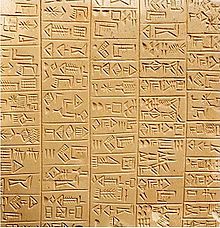- Cuneiform
-
"Cuneiform" redirects here. For other uses, see Cuneiform (disambiguation).
Cuneiforms Type Logographic and syllabic Languages Akkadian, Eblaite, Elamite, Hattic, Hittite, Hurrian, Luwian, Sumerian, Urartian Time period c. 30th century BC to 1st century AD Parent systems (Proto-writing)- Cuneiforms
Child systems Egyptian hieroglyphs[citation needed]
Old Persian
UgariticISO 15924 Xsux, 020 Direction Left-to-right Unicode alias Cuneiform Unicode range U+12000 to U+123FF (Sumero-Akkadian Cuneiform)
U+12400 to U+1247F (Numbers)Note: This page may contain IPA phonetic symbols. Cuneiform script (
 /kjuːˈniːɨfɔrm/ kew-nee-i-form or /ˈkjuːnɨfɔrm/ kew-ni-form (/ˈkjuːnɪfɔːm/ (British))) is one of the earliest known forms of written expression. Emerging in Sumer around the 30th century BC, with predecessors reaching into the late 4th millennium (the Uruk IV period), cuneiform writing began as a system of pictographs. In the three millennia the script spanned, the pictorial representations became simplified and more abstract as the number of characters in use also grew gradually smaller, from about 1,000 unique characters in the Early Bronze Age to about 400 unique characters in Late Bronze Age (Hittite cuneiform).
/kjuːˈniːɨfɔrm/ kew-nee-i-form or /ˈkjuːnɨfɔrm/ kew-ni-form (/ˈkjuːnɪfɔːm/ (British))) is one of the earliest known forms of written expression. Emerging in Sumer around the 30th century BC, with predecessors reaching into the late 4th millennium (the Uruk IV period), cuneiform writing began as a system of pictographs. In the three millennia the script spanned, the pictorial representations became simplified and more abstract as the number of characters in use also grew gradually smaller, from about 1,000 unique characters in the Early Bronze Age to about 400 unique characters in Late Bronze Age (Hittite cuneiform).The original Sumerian script was adapted for the writing of the Akkadian, Eblaite, Elamite, Hittite, Luwian, Hattic, Hurrian, and Urartian languages, and it inspired the Ugaritic and Old Persian alphabets. Cuneiform writing was gradually replaced by the Phoenician alphabet during the Neo-Assyrian Empire, and by the 2nd century AD, the script had become extinct.
Cuneiform documents were written on clay tablets, by means of a blunt reed for a stylus. The impressions left by the stylus were wedge shaped, thus giving rise to the name cuneiform ("wedge shaped", from the Latin cuneus, meaning "wedge").
Contents
History
The cuneiform writing system was in use for more than 35 centuries, through several stages of evolution, from the 34th century BC down to the 1st century AD.[1] It was completely replaced by alphabetic writing (in the general sense) in the course of the Roman era and there are no Cuneiform systems in current use. For this reason, it had to be deciphered from scratch in 19th century Assyriology. Successful completion of decipherment is dated to 1857.
The system consists of a combination of logophonetic, consonantal alphabetic and syllabic signs.[2]
The cuneiform script underwent considerable changes over a period of more than two millennia. The image below shows the development of the sign SAG "head" (Borger nr. 184, U+12295 Wikimedia Foundation. 2010.
CuneiForm — Тип оптическое распознавание символов Автор Cognitive Technologies Разработчики команда CuneiForm Linux Написана на C, C++ Интерфейс … Википедия
CuneiForm — Entwickler Cognitive Technologies Aktuelle Version 0.1.0 (14. Februar 2009) Betriebssystem Windows (Linux und FreeBSD Portierungen verfügbar) Kategorie … Deutsch Wikipedia
cuneiform — CUNEIFÓRM, Ă, cuneiformi, e, adj. Care este în formă de cui. ♢ Scriere cuneiformă = sistem de scriere cu litere în formă de cuie săpate în piatră sau imprimate pe tăbliţe de argilă, folosit de unele popoare orientale antice. ♦ (Substantivat, f.)… … Dicționar Român
Cuneiform — Cu*ne i*form (k? n? ? f?rm), Cuniform Cu ni*form (k? n? f?rm), a. [L. cuneus a wedge + form: cf. F. cunei forme. See {Coin}.] 1. Wedge shaped; as, a cuneiform bone; especially applied to the wedge shaped or arrowheaded characters of ancient… … The Collaborative International Dictionary of English
Cuneiform — (lat. cuneus, Keil) kann sich beziehen auf: das Keilbein, siehe Os cuneiforme cuneiform script, engl. für Keilschrift eine Texterkennungssoftware, siehe CuneiForm … Deutsch Wikipedia
cuneiform — ► ADJECTIVE 1) relating to the wedge shaped characters used in the ancient writing systems of Mesopotamia, Persia, and Ugarit. 2) chiefly Biology wedge shaped. ► NOUN ▪ cuneiform writing. ORIGIN from Latin cuneus wedge … English terms dictionary
cuneiform — [kyo͞o nē′ə fôrm΄, kyo͞o′nē əfôrm΄] adj. [< L cuneus (see CUNEAL) + FORM] 1. wedge shaped 2. designating the characters in ancient Akkadian, Assyrian, Babylonian, and Persian inscriptions, or the inscriptions themselves n. cuneiform characters … English World dictionary
Cuneiform — Cu*ne i*form, Cuniform Cu ni*form, n. 1. The wedge shaped characters used in ancient Persian and Assyrian inscriptions. I. Taylor (The Alphabet). [1913 Webster] 2. (Anat.) (a) One of the three tarsal bones supporting the first, second third… … The Collaborative International Dictionary of English
cuneiform — (adj.) 1670s, wedge shaped, from Fr. cunéiforme (16c.), from L. cuneus a wedge, wedge shaped thing, of unknown origin, + Fr. forme (see FORM (Cf. form) (n.)). Applied to characters in ancient Middle Eastern inscriptions made with wedge shaped… … Etymology dictionary
cuneiform — meaning ‘ancient wedge shaped writing’, is now normally pronounced as three syllables in BrE, i.e. kyoo ni fawm, and as four in AmE, i.e. kyoo nay i fawm … Modern English usage

